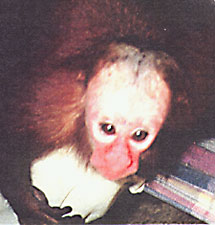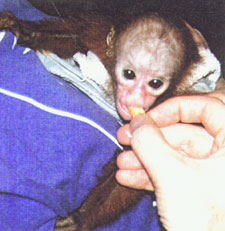INTERNATIONAL SOCIETY for the Preservation of the Tropical Rainforest
Animal Orphanage
At “Dolphin Corners” we have an animal orphanage to assist animals that have been confiscated from the black market, abused, abandoned, and their parents killed for food.
A number of different species of monkeys have fallen into our caring hands over the years. The rarest and most bizarre monkey as of yet is the “Red Bald-Faced Uakaris” (C. Calvus Rubicundus).
These monkeys are extremely rare and endangered, so any help we get will do volumes towards protecting them. There are only two Uakari monkeys that we know of in the world that are in captivity, and they reside in the Los Angeles Zoo.
A very loving one-and-a-half old female. Mistakenly, we sexed Amadeus as a boy when she was a baby. It is very hard to sex these monkeys at such an early age. She is the dominant one of the group.
Ludwig is more of a thinker, preferring to keep to his thoughts until his monkey nature gets the best of him. Only then will he play on his swing or on his striped hammock. Or if he likes you, he may even steal your glasses. He is also one-and-a-half years old.
Here is Amadeus at two weeks old and Ludwig at only one week old in their plastic box, that can be cleaned easily (see photograph to the right). Roxanne had to feed them every two hours to ensure that they would live. She also put the plastic box in her bed at night to listen for any complications that could have arisen. When she took them out of the box to feed them milk from a bottle, just as a human would feed their baby with a bottle, they were comforted by the nourishment and Roxanne’s heartbeat.
As they got older and didn’t need to be fed every 2 hours, we put a ticking wind-up clock in their sleeping quarters to simulate the beating of a heart as a comforting device. As you see above, the monkeys are doing just fine.
Because this shy and sensitive species of monkey is extremely difficult to raise, Roxanne thought it necessary to sleep with them for two weeks so they could hear her heart beating, as they would with their mothers. Roxanne learned this technique years ago while working at the Lincoln Park Zoo Nursery in Chicago, Illinois. Roxanne also had to feed the monkeys every hour on the hour.
The reason they came to “Dolphin Corners” Animal Orphanageis because our neighbors, the Jivaro Indians, ate the mother and fathers because the uakari is a traditional food item they have eaten for generations. ISPTR doesn’t want to interfere with their traditions, but we also don’t want species such as the uakari to go extinct. The uakari is on the “extinction” list by C.I.T.I.E.S. There is a delicate balance we are trying to achieve that will sustain all life for generations to come.
Tinker is a rollicking, little one year old female who prefers her milk in a bowl as opposed to a baby bottle. This mode of drinking gives her a nice sized “milk- beard.” She loves to be brushed until her coat is smooth and silky. We think she’s a little vain, and we love her very much.
This little guy is only four months old. He is so full of energy and life that we nicknamed him “Duracell” because he can’t sit still for even a moment. Shatzy came to us in January 1998 when he was dropped by his mother, who was being hunted at the time for food. How sad the mother must be to lose her baby this way, if she is still alive.
What makes the “Red Bald-Faced Uakaris” different from
other monkeys?
“Let’s just say they are very different from other monkeys,” remarks David Olive, the 24-hour medical clinic doctor and official uakari caretaker. He is their surrogate father, having raised them from a young age. They are more human-like than most monkeys in that they are not as destructive. In addition, they have only a stump where their prehensile tail should be as they are a New World monkey. This means that they climb exclusively with their hands and feet, which can often be difficult to tell apart.
Just imagine a monkey about two-and-a-half pounds, covered with long red hair except the face, with a short stumpy tail that wags like a dog when excited, and is full of energy producing all kinds of interesting chirps, clucks, and whistles to demonstrate itself. They may even rear up on their feet and walk up to thirty paces. “Not your average monkey,” observes David.
What do these Uakaris eat?
Unfortunately, these monkeys never had the chance to be raised by their mothers in their natural environment. In human hands, they choose to eat what we eat and refuse traditional monkey goodies such as caterpillars, insects, etc. Some of what they eat includes, celery, fresh greens, green string beans, corn on the cob, raw sweet potatoes, apples, oranges, bananas, hard bread, some seeds, and some near-ripe fruit. They love milk and baby powder formula as a wake-up and bed-time treat. Water is always in demand in the hot, humid jungle. We still experiment with foods they might eat out of our supplies. We’re trying to raise them the best we can with the little knowledge and financial resources we have. Each monkey costs about $35 a week to properly feed and care for them. We now have a fifth male monkey named Franz Litz that was brought to us at one-month- old, during our children’s annual “Dolphin Olympics” held July 1, 1998. It costs us $175 a week to feed these five monkeys. Our success has been very good as we have not lost a uakari for almost two years.
Contact us today for information about adopting an animal.
Reach Us
Contact
pard_expeditions@yahoo.com






